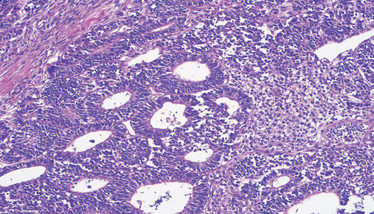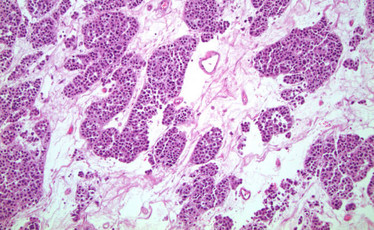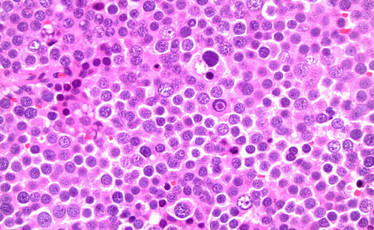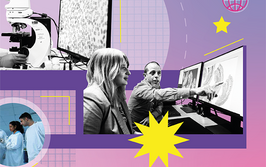Case of the Month

This renal tumor removed from a four-year-old child may be found in which hereditary syndrome?
a. WAGR
b. Lynch syndrome
c. Multiple endocrine neoplasia type I
d. Li-Fraumeni syndrome
Click here to register your guess.
We will reveal the answer next month.
Do you have an interesting case that you would like us to feature? Email it to [email protected]
Answer to February’s Case of the Month...


C. Sarcomatous change
The images indicate a diagnosis of spermatocytic tumor. This tumor is rare (0.61 percent of all testicular germ cell tumors) and most commonly affects men in their fifth and sixth decades. It presents as a painless, usually unilateral testicular mass. Serum tumor markers are typically negative, and gross examination is characterized by a homogeneous, pale grey, solid, soft-textured tumor confined to the testis. Areas of necrosis, edema, lobulation and hemorrhage may also be present. Until recently, these tumors were known as spermatocytic seminoma. However, there is no association with seminoma or germ cell neoplasia in situ (GCNIS) and, in the absence of sarcomarous change, they are benign. For these reasons, spermatocytic seminoma has been renamed spermatocytic tumor.
Three morphologically distinct cell types are noted on microscopy: small cells with hyperchromatic nuclei and scant cytoplasm resembling lymphocytes; medium (intermediate)-sized cells with round nuclei, granular chromatin, and dense eosinophilic cytoplasm; and large, mono-multinucleated cells with round, indented nuclei and lacy chromatin. Mitoses are common and include atypical forms. The intermediate cells are often predominant and the other cell types may only be recognized when examining additional sections. GCNIS is absent and fibrous stroma, granulomas, and lymphocytes are not features of spermatocytic tumor.
The tumor cells do not demonstrate intracytoplasmic glycogen on PAS staining and are negative for most immunohistochemical markers characteristic of other germ cell tumors. c-Kit may be expressed in up to 40 percent of spermatocytic tumors. The lack of a lymphoid component, as demonstrated by the absence of staining with CD45, further underscores the diagnosis in the case presented here. Gain in chromosome 9 is the most consistent cytogenetic abnormality, in addition to gain of the X chromosome.
Prominent nucleoli and marked nuclear pleomorphism reminiscent of embryonal carcinoma, including bizarre multinucleated cells, are considered anaplastic change. Undifferentiated and differentiated sarcomatous elements indicate sarcomatous change and are more likely to metastasize. Sarcomatous change incurs a worse prognosis due to metastatic potential, whereas anaplastic change does not (1,2,3).
Courtesy of PathologyOutlines.com. Case by Debra Zynger, Associate Professor and Director of the Division of Genitourinary Pathology, The Ohio State University Wexner Medical Center, Columbus, USA; discussion by Belinda Lategan, Associate Professor and Pathologist at St. Boniface Hospital, Winnipeg, Canada.
References
- SR Williamson et al., “The World Health Organization 2016 classification of testicular germ cell tumours: a review and update from the International Society of Urological Pathology Testis Consultation Panel”, Histopathology, 70, 335–346 (2017). PMID: 27747907.
- J Matoska, A Talerman, “Spermatocytic seminoma associated with rhabdomyosarcoma”, Am J Clin Pathol, 94, 89–95 (1990). PMID: 2252471.
- LD True et al., “Spermatocytic seminoma of testis with sarcomatous transformation. A report of five cases”, Am J Surg Pathol, 12, 75–82 (1988). PMID: 3341514.




















